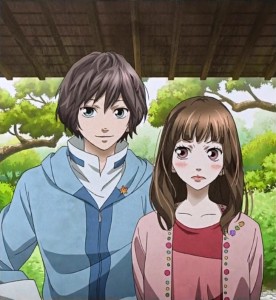HAL and Artificial Intelligences
March 22, 2015 · 0 comments
By Andrew Osmond
 Garden of Words reminded us that a small anime can be beautiful in all ways; visually gorgeous, emotionally intimate, celebrating the real scenery of Japan. HAL has the same blend, though with an SF element. Like Garden, it’s a self-contained short story, only an hour long, but full of exquisitely-detailed images.
Garden of Words reminded us that a small anime can be beautiful in all ways; visually gorgeous, emotionally intimate, celebrating the real scenery of Japan. HAL has the same blend, though with an SF element. Like Garden, it’s a self-contained short story, only an hour long, but full of exquisitely-detailed images.
Once more, boy meets girl. But this boy is a robot and he’s been made to look like the girl’s dead boyfriend, to help her through her grief. The setting for their tale is not some future city, but a very old-world Kyoto that’s escaped Blade Runner makeovers. It’s all elegant wooden houses and stone waterways, where people sew and dye by hand. The climax happens during the Gion Matsuri, a centuries-old festival held each July, when giant floats trundle through the city.
HAL’s production studio is famed for another SF anime in an old-fashioned city, one threatened by man-eating giants! Yes, HAL is by the same folks as the anime Attack on Titan. Their studio is WIT, an independent offshoot of Production I.G. In recent years, I.G has used woman artists to add a feminine touch to material once stereotyped as “for boys.” There was CLAMP’s work on the horror Blood-C, for example, and Chica Umino (Honey and Clover) creating character designs for the action-comedy Eden of the East.
With HAL, WIT takes a leaf from I.G’s book. The film uses character designs by woman artist Io Sakisaka, whose strips include Strobe Edge and Ao Haru Ride (aka Blue Spring Ride), both teen romances. Incidentally, Sakisaka’s strip Blue Spring Ride was serialised as an anime last summer, made by… Production I.G. Drawn as a wide-eyed innocent, the robot boy Hal feels like a bishonen cousin to Data in Star Trek The Next Generation or David in A.I. Artificial Intelligence.
Both of those titles explored one of HAL’s core themes; the use of an android to meet the ultimate human ache, to compensate for the loss of a loved one. In HAL, the robot has been made to look exactly like a dead person. In effect, the titular Hal is like a photograph, but one who can speak and touch and act.
This is an idea with a very long history. Centuries ago, for example, there was a legend about the philosopher Rene Descartes (the ‘I think therefore I am’ guy). According to the story, examined here, Descartes used to travel around with a lifelike, life-sized mechanical doll – in effect a robot. This robot was modelled on Descartes’ late daughter Francine, who’d died at the age of five. The story was sometimes used for nasty innuendo, but it can be seen as an early melding of grief and robotics. It’s referenced in Mamorou Oshii’s film, Ghost in the Shell: Innocence.
Maybe Osamu Tezuka knew the story too. The backstory of his famous character Astro Boy, originally created in a 1952 manga, has another father broken by the death of his child. Much like Descartes, the father tries to recreate the child in robot form, but then rejects him for not being close enough. This angle is played up especially in the underrated CG film version of Astro Boy, made in 2009 by the Imagi studio. Steven Spielberg’s live-action film A.I. Artificial Intelligence starts with a variant on the same idea. A little boy replaces a child whose disease has put him into suspended animation; but then the real child recovers, and the android ends up a wandering Pinocchio.
One of the most recent (and dark) takes on the robot replacement theme is “Be Right Back,” a TV episode of Charlie Brooker’s techno-nightmare series Black Mirror. In this, Artificial Intelligences can simulate the personalities of dead people based on their online footprints and Facebook statuses.
There are also, more broadly, tales of compassionate robots helping humans through grief. Star Trek: Next Generation did it more than once; for example, “Hero Worship,” where a traumatised child convinces himself he’s an android, and is humoured by a real android. Disney’s recent movie Big Hero 6 is about a similarly angelic robot (looking like a giant marshmallow), who again helps a boy through bereavement, though ‘help’ in this case involves getting built up as an armoured superhero and fighting crime.
The HAL film is the director debut of Ryotaro Makihara, who previously worked on Guilty Crown, but also on the far quirkier Tatami Galaxy, by mad director Masaaki Yuasa (Ping Pong). In an interview, Makihara hinted he wanted to lure audiences into HAL with the glamour of a cute girl and a pretty boy, before presenting deeper themes. HAL is, after all, about death and grief, though told with humour and whimsy; it has a Ponyo-ish chorus of old folks and the adventures of an oversized model giraffe. Despite its title robot boy, HAL is a funny-sad slice of very human life.
Andrew Osmond is the author of 100 Animated Feature Films. HAL is available on UK DVD from Anime Ltd.
anime, Artificial Intelligence, HAL, Japan, Production I.G., Ryotaro Makihara, science fiction
Anime Limited Newswire #12 – 24th March 2015 – All the Anime
March 24, 2015 5:04 pm
[…] HAL And Artificial Intelligences […]
Plastic Memories – All the Anime
April 13, 2015 4:25 am
[…] of mortality. The idea of androids as therapists to humans also turned up in the recent anime HAL, where a robot helped a human through grief. HAL’s director Ryotaro Makihara connected this idea […]